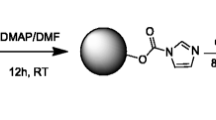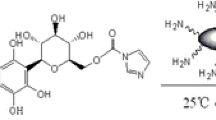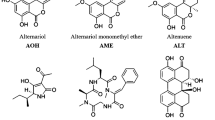Abstract
Daidzin (DZ) and genistin (GEN) are the main glucosidic components of soy isoflavone; the detection of DZ and GEN can provide insight for the appropriate ingestion of soy products. An indirect competitive chemiluminescence immunoassay (icCLIA) method based on N-(aminobutyl)-N-(ethylisoluminol) (ABEI) as chemiluminescent (CL) label was developed to assay DZ in soy products. Meanwhile, GEN also could be determined due to the cross reaction with DZ monoclonal antibody (MAb). Fluorescein isothiocyanate (FITC) was used to label the pure DZ antigen to compete with DZ in toy products. Magnetic beads (MBs) capped with anti-FITC antibody were both the solid phase and separator. The chemiluminescence signal produced by the emission of photons from ABEI was inversely proportional to the amount of DZ and GEN in the sample solution. The method was linear to 6000 ng/mL DZ with a detection limit of 1.34 ng/mL. The intra-assay imprecision results [mean (coefficient of variation, CV)] were less than 6%. The average recoveries ranged from 92 to 98%. The relationship between the proposed method and high-performance liquid chromatography (HPLC) exhibited a correlation. The proposed method demonstrates acceptable performance for rapid quantification of DZ and GEN and can be used to rapidly detect these substances in soy products.

Similar content being viewed by others
References
Bacigalupo MA, Ius A, Simoni P, Piazza F, Roda A, Setchell KD (2001) Analytical performance of luminescent immunoassays of different format for serum daidzein analysis. Fresenius J Anal Chem 370:82–87
Beekmann K, de Haan LH, Actis-Goretta L, Houtman R, van Bladeren PJ, Rietjens IM (2015) The effect of glucuronidation on isoflavone induced estrogen receptor (ER)alpha and ERbeta mediated coregulator interactions. J Steroid Biochem Mol Biol 154:245–253. doi:10.1016/j.jsbmb.2015.09.002
Buathong N, Poonyachoti S, Deachapunya C (2015) Isoflavone genistein modulates the protein expression of toll-like receptors in cancerous human endometrial cells. J Med Assoc Thail 98 Suppl 9:S31–S38
Bustamante-Rangel M, Delgado-Zamarreno MM, Carabias-Martinez R, Dominguez-Alvarez J (2012) Analysis of isoflavones in soy drink by capillary zone electrophoresis coupled with electrospray ionization mass spectrometry. Anal Chim Acta 709:113–119. doi:10.1016/j.aca.2011.10.015
Chan SA, Lin SW, Yu KJ, Liu TY, Fuh MR (2006) Quantitative analysis of isoflavone aglycones in human serum by solid phase extraction and liquid chromatography-tandem mass spectrometry. Talanta 69:952–956. doi:10.1016/j.talanta.2005.11.047
Chao Z et al (2013) Development of an indirect competitive enzyme-linked immunosorbent assay (icELISA) using highly specific monoclonal antibody against paclitaxel. J Nat Med 67:512–518. doi:10.1007/s11418-012-0708-1
Cheng G, Wilczek B, Warner M, Gustafsson JA, Landgren BM (2007) Isoflavone treatment for acute menopausal symptoms. Menopause 14:468–473. doi:10.1097/GME.0b013e31802cc7d0
Feng B, Jin J, Wang C, Song J, Yang G, Zeng A (2012) Analysis and retention behavior of isoflavone glycosides and aglycones in Radix Astragali by HPLC with hydroxypropyl-beta-cyclodextrin as a mobile phase additive. J Sep Sci 35:3469–3476. doi:10.1002/jssc.201200389
Han HWS (2012) Determination of genistein by flow-injection chemiluminescence method based on ferricyanide oxidation sensitized by Rhodamine 6G. J Chin Chem Soc 59:7
He JT, Shi ZH, Yan J, Zhao MP, Guo ZQ, Chang WB (2005) Biotin-avidin amplified enzyme-linked immunosorbent assay for determination of isoflavone daidzein. Talanta 65:621–626. doi:10.1016/j.talanta.2004.07.027
Heinonen S, Wahala K, Adlercreutz H (1999) Identification of isoflavone metabolites dihydrodaidzein, dihydrogenistein, 6′-OH-O-dma, and cis-4-OH-equol in human urine by gas chromatography-mass spectroscopy using authentic reference compounds. Anal Biochem 274:211–219. doi:10.1006/abio.1999.4279
How healthy are soy burgers? New AOAC method determines isoflavone content in today’s soy foods (2001) J AOAC Int 84:90A-92A
Hubert J, Berger M, Dayde J (2005) Use of a simplified HPLC-UV analysis for soyasaponin B determination: study of saponin and isoflavone variability in soybean cultivars and soy-based health food products. J Agric Food Chem 53:3923–3930. doi:10.1021/jf047828f
Lopez-Gutierrez N, Romero-Gonzalez R, Garrido Frenich A, Martinez Vidal JL (2014) Identification and quantification of the main isoflavones and other phytochemicals in soy based nutraceutical products by liquid chromatography-orbitrap high resolution mass spectrometry. J Chromatogr A 1348:125–136. doi:10.1016/j.chroma.2014.04.090
Lutter S, Schmalbach K, Esch HL, Lehmann L (2014) The isoflavone irilone contributes to the estrogenic potential of dietary supplements containing red clover. Arch Toxicol 88:309–321. doi:10.1007/s00204-013-1114-5
Niiho Y et al (2010) Simultaneous analysis of isoflavones and saponins in Pueraria flowers using HPLC coupled to an evaporative light scattering detector and isolation of a new isoflavone diglucoside. J Nat Med 64:313–320. doi:10.1007/s11418-010-0411-z
Pu L et al (2013) Development of a chemiluminescence immunoassay for serum YB-1 and its clinical application as a potential diagnostic marker for hepatocellular carcinoma. Hepat Mon 13:e8918. doi:10.5812/hepatmon.8918
Qing LS, Xue Y, Liu YM, Liang J, Xie J, Liao X (2013) Rapid magnetic solid-phase extraction for the selective determination of isoflavones in soymilk using baicalin-functionalized magnetic nanoparticles. J Agric Food Chem 61:8072–8078. doi:10.1021/jf402097y
Qu H et al (2016) Rapid, sensitive separation of the three main isoflavones in soybean using immunoaffinity chromatography. J Sep Sci 39:1195–1201. doi:10.1002/jssc.201501052
Ruiz-Delgado A, Martinez-Dominguez G, Romero-Gonzalez R, Lopez-Ruiz R, Frenich AG (2016) Determination of polycyclic aromatic hydrocarbons in soy isoflavone nutraceutical products by gas chromatography coupled to triple quadrupole tandem mass spectrometry. J Sep Sci 39:528–536. doi:10.1002/jssc.201500992
Sakamoto S, Yusakul G, Pongkitwitoon B, Paudel MK, Tanaka H, Morimoto S (2015) Simultaneous determination of soy isoflavone glycosides, daidzin and genistin by monoclonal antibody-based highly sensitive indirect competitive enzyme-linked immunosorbent assay. Food Chem 169:127–133. doi:10.1016/j.foodchem.2014.08.004
Sakamoto S, Yusakul G, Pongkitwitoon B, Tanaka H, Morimoto S (2016) Colloidal gold-based indirect competitive immunochromatographic assay for rapid detection of bioactive isoflavone glycosides daidzin and genistin in soy products. Food Chem 194:191–195. doi:10.1016/j.foodchem.2015.08.002
Saracino MA, Raggi MA (2010) Analysis of soy isoflavone plasma levels using HPLC with coulometric detection in postmenopausal women. J Pharm Biomed Anal 53:682–687. doi:10.1016/j.jpba.2010.06.001
Shim YS, Yoon WJ, Hwang JB, Park HJ, Seo D, Ha J (2015) Rapid method for the determination of 14 isoflavones in food using UHPLC coupled to photo diode array detection. Food Chem 187:391–397. doi:10.1016/j.foodchem.2015.04.077
Singleton H et al (2016) Anti-hapten antibodies in response to skin sensitization. Contact Dermatitis 74:197–204. doi:10.1111/cod.12486
Soukup ST, Al-Maharik N, Botting N, Kulling SE (2014) Quantification of soy isoflavones and their conjugative metabolites in plasma and urine: an automated and validated UHPLC-MS/MS method for use in large-scale studies. Anal Bioanal Chem 406:6007–6020. doi:10.1007/s00216-014-8034-y
Taku K et al (2010) Effects of soy isoflavone extract supplements on blood pressure in adult humans: systematic review and meta-analysis of randomized placebo-controlled trials. J Hypertens 28:1971–1982. doi:10.1097/HJH.0b013e32833c6edb
Tian D, Duan C, Wang W, Li N, Zhang H, Cui H, Lu Y (2009) Sandwich-type electrochemiluminescence immunosensor based on N-(aminobutyl)-N-ethylisoluminol labeling and gold nanoparticle amplification. Talanta 78:399–404. doi:10.1016/j.talanta.2008.11.037
Toro-Funes N, Odriozola-Serrano I, Bosch-Fuste J, Latorre-Moratalla ML, Veciana-Nogues MT, Izquierdo-Pulido M, Vidal-Carou MC (2012) Fast simultaneous determination of free and conjugated isoflavones in soy milk by UHPLC-UV. Food Chem 135:2832–2838. doi:10.1016/j.foodchem.2012.06.011
Tse G, Eslick GD (2016) Soy and isoflavone consumption and risk of gastrointestinal cancer: a systematic review and meta-analysis. Eur J Nutr 55:63–73. doi:10.1007/s00394-014-0824-7
Uifalean A, Farcas A, Ilies M, Heghes SC, Ionescu C, Iuga CA (2015) Assessment of isoflavone aglycones variability in soy food supplements using a validated HPLC-UV method. Clujul Med 88:373–380. doi:10.15386/cjmed-468
Wang Q, Ge X, Tian X, Zhang Y, Zhang J, Zhang P (2013) Soy isoflavone: the multipurpose phytochemical (Review). Biomed Rep 1:697–701. doi:10.3892/br.2013.129
Wu J et al (2004) Combined intervention of soy isoflavone and moderate exercise prevents body fat elevation and bone loss in ovariectomized mice. Metab Clin Exp 53:942–948
Zhang H, Qi S (2011) A rapid and sensitive chemiluminescence immunoassay based on magnetic particles for squamous cell carcinoma antigen in human serum. Clinica Chimica Acta 412(17–18), 1572–1577. doi:10.1016/j.cca.2011.05.005
Author information
Authors and Affiliations
Corresponding authors
Ethics declarations
Funding
This work was supported by the Project of the National Science Foundation of China (Grant nos. 61401285 and 81401750), Guangdong Science Plan (Nos. 2013B021800097 and 2014A020212038), and Shenzhen Science Plan (Nos. JCYJ20160307114925241 JCYJ20140418182819179, JCYJ20150330102720122, and cxzz201418182638764).
Conflict of Interest
Suwen Qi declares that she has no conflict of interest. Depeng Xu declares that he has no conflict of interest. Qiwen Chen declares that he has no conflict of interest. Pu Li declares that he has no conflict of interest. Ni Xie declares that he has no conflict of interest. Qin Huo declares that he has no conflict of interest.
Ethical Approval
This article does not contain any studies with human or animal subjects.
Informed Consent
Not applicable
Rights and permissions
About this article
Cite this article
Qi, S., Xu, D., Chen, Q. et al. Indirect Competitive Chemiluminescence Immunoassay for Glycosides Daidzin and Genistin in Soy Products. Food Anal. Methods 11, 367–373 (2018). https://doi.org/10.1007/s12161-017-1007-y
Received:
Accepted:
Published:
Issue Date:
DOI: https://doi.org/10.1007/s12161-017-1007-y




